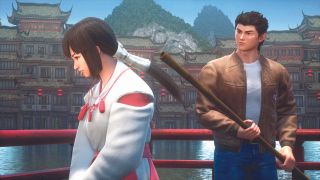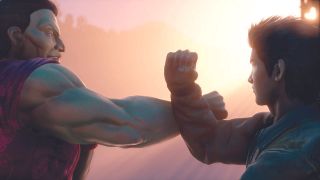Shenmue 3 is more than pure nostalgia
The devs promise deeper RPG systems, detailed towns, and more character development.

Once upon a time, lavish martial arts adventure Shenmue was the most expensive videogame ever made. So expensive that when it failed to live up to sales expectations it contributed to the demise of the Dreamcast. A sequel was released in the west on the original Xbox, but it couldn’t stop the inevitable—Shenmue was, essentially, dead.
Which makes the existence of a third game something of a miracle. Almost 20 years later, after tireless campaigning from the game’s vocal and dedicated fanbase, Ryo Hazuki’s story will continue. Creator Yu Suzuki is back at the helm, and the story picks up where it left off in Shenmue II. Ryo finds himself in rural China, on the trail of Lan Di, the man who murdered his father. Shenmue III raised over $7 million on Kickstarter, illustrating how hungry people are to see an end to—or a continuation of—Ryo’s story.
Shenmue III begins in a sleepy village called Bailu, which is a radical change of scenery from the first game’s Japanese suburbs and the second’s bustling Hong Kong streets. The village is nestled deep in the mist-shrouded mountains of Guilin, China, a region Yu Suzuki himself visited while researching the project. Shenmue is famous for its attention to detail, and it’s heartening to see that Suzuki is still dedicated to creating authentic, atmospheric worlds. You’ll visit more urbanised, city-like locations later in the game, but the bulk of the opening hours will revolve around Bailu.
Like the first game, all the villagers in Bailu will have their own routines, homes, and personalities. This is a return to the more close-knit, parochial feel of Yokosuka, rather than the chaotic, impersonal bustle of Hong Kong, which should make for a much more immersive setting. Through these people you’ll learn about the culture and history of China, but unlike the Dreamcast games, not everyone you meet will immediately want to tell you their whole life story.

Ryo asks around for clues about Lan Di, but the villagers are reluctant to talk to him—cold, even. This is an example of the new Affinity system, which requires you to get to know people, or earn a reputation, before they’ll trust you enough to reveal important information. Shenmue is, at its core, a detective game, and this should make the investigation parts of it much more interesting and dynamic. And it makes sense from a story perspective, because an isolated village like this would be wary of strangers wandering around asking questions.
Accompanying Ryo is Shenhua, a woman who appeared in visions in the first two games, and briefly at the end of Shenmue II. She and Ryo share some kind of deep, mystical bond that will be explored more deeply in Shenmue III. But she also comes in handy when you’re trying to get the people of Bailu, her home village, on your side. If you talk to someone alone they might not be receptive to your questions, but with Shenhua in tow they’ll realise you’re a friend and be more willing to speak. She’s certainly a handy person to have around.
Fight club
As well as playing detective, Ryo also spends a lot of time fighting. The combat in the original games was rooted in Suzuki’s Virtua Fighter series. Shenmue III features the same chunky arcade animation, but with smoother transitions between moves and a greater sense of physicality. The combat will also be bolstered by an RPG-style progression system. Ryo can take part in a number of timing-based training minigames that will increase his key stats: Attack Power and Endurance. Developing these will then boost a third stat, Kung Fu, which unlocks advanced fighting techniques.
PC Gamer Newsletter
Sign up to get the best content of the week, and great gaming deals, as picked by the editors.
Training is all about timing, reaction, and dexterity. One challenging minigame called Horse Stance involves Ryo holding himself in an uncomfortable-looking position, which you have to keep him in by rhythmically tapping a button. Fail to hold the pose and you’ll have to try again, but maintaining it will increase your Endurance stat. Alternatively, if you want to increase your Attack Power, there’s the one-inch punch minigame, based on the move popularised by Bruce Lee. This involves hitting a dummy in time with an on-screen prompt, and the window to strike gets narrower with each hit.

But if you want something a little more dangerous than wooden training dummies, you can practice your martial arts against real people. A local dojo will offer up students to spar with, or you can visit the Rose Garden. Located on the grounds of a beautiful, ornate temple, this is a fighting club where you can pay to battle increasingly skilled opponents. If you can defeat them, not only will you get a much bigger boost to your stats, but you’ll earn some decent cash too. This is an optional activity, but one that’ll be worth dedicating time to.
There are some light RPG elements in Shenmue III too. Ryo’s Endurance stat extends to running in the world, and his stamina will drain as you sprint around. To restore it you can buy food from convenience stores, and munching some chow before an important battle will become a part of your routine. While you could train and develop moves in the original games, there was no clear feedback that you were improving. But here Ryo’s growth is clearly conveyed through progression meters, making it much more satisfying.
Ryo himself is the same as ever—sullen, oblivious, and prone to asking bizarre questions. For Suzuki it was important to retain this aspect of his personality, because fans love it. But he also promises that Ryo will grow as a character in III. The futility of his quest for revenge is a big part of the first two games. People are forever telling him what a stupid idea following Lan Di is, which he brushes off. But hopefully, in this game, some of that will finally get through to him.
Oh, and fans will be glad to know that Corey Marshall, the voice of Ryo in the English dub, is returning—not to mention composer Ryuji Iuchi, scriptwriter Masahiro Yoshimoto, and character designer Kenji Miyawaki. Suzuki has also hired architect Manabu Takimoto to ensure the various buildings in the game are authentic, something he did in the first two games, which resulted in a grounded and convincing setting. It’s clear a lot of love is being poured into Shenmue III, and it’s great to see so many key members of the original development team coming back to finish the job.

I’m also encouraged by the fact that Suzuki says Shenmue III will feel like a Shenmue game, and that he’s resisting the influence of modern open world games. The camera controls have been tweaked, but otherwise this will control the same as the first two games. You can still switch to a first-person camera and look around, and you can still interact with drawers and cupboards to find hidden items. Fan favourite features including QTEs, arcades with playable games, and the all-important capsule toy machines are also making a comeback.
New ground
This stuff will conjure up warm, fuzzy memories for fans, but I’m convinced Shenmue III doesn’t just exist to milk nostalgia. The deeper combat, RPG elements and Affinity system are examples of Suzuki pushing things forward, and I’m sure there are more new systems waiting to be revealed. It’s been confirmed that Ryo will be able to, as before, get a job and earn money, but developer Ys Net is keeping the details of that aspect of the game close to its chest. I have my fingers crossed for the forklift trucks to return, but I can take or leave that crate-shifting minigame from II.
At this point it’s too early to say whether Shenmue III will live up to the previous two games. But if it’s half as weird, heartfelt and stupidly detailed, I’ll be happy. I never thought I’d see the day Ryo Hazuki’s story would be continued, let alone 20 years later, so that alone is worth celebrating. Suzuki clearly has a fondness for Shenmue, and it’s evident in the way he talks about this new game that he really cares about making a worthy sequel. It isn’t out till November, which is the perfect excuse to play (or replay) Shenmue I and II. The superb remaster collection released for PC last year.
If it’s set in space, Andy will probably write about it. He loves sci-fi, adventure games, taking screenshots, Twin Peaks, weird sims, Alien: Isolation, and anything with a good story.
Most Popular





